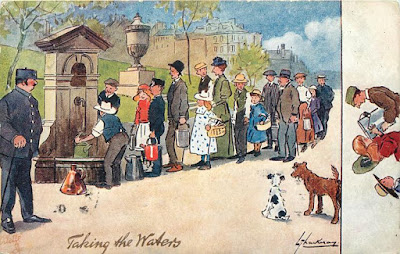Introduction
Over a three
day weekend in June 1992 the “Friends of Buxworth / Bugsworth School
inaugurated the first “Bygone Buxworth”. It was to be held in Buxworth School.
The turnout was something to write home about. The school was packed to the
gunnel's with past and present villagers jostling to see both the historical
displays and to meet up with long lost friends. The outcome at a post mortem
meeting was that with the numerous offerings of more historical material and
the interest generated, that a further 10 day exhibition would be staged when
the school was not operational during the summer. This occurred in the summer
of 1994.
A taste of what
was on offer in 1992 follows. The Navigation Inn staged a “Canal Themed Weekend”
Richard Hall, the then Chinley milkman brought his shire horses to the
Bugsworth Basin. Opposite Buxworth School a slide show and lecture entitled
“The Peak Forest Canal and the Bugsworth Basin” was held in the former
Primitive Methodist Tabernacle Chapel A
display of old photographs and documents was mounted in the main schoolroom.
Morris Dancers, Clog Dancers, Live Theatre and a Jazz and Blues Band filled in
the gaps. I produced a 28 page booklet plainly entitled “Bugsworth” for the
occasion. An amalgam of local residents recounted businesses and ventures that
I edited into an article entitled “Shop-keeping in Bugsworth over 60 years.”
Other villagers contributed various Bugsworth / Buxworth related articles. The booklet sold well and feedback came back
fast and furious, mostly landing into my possession as the historical editor.
One of the families mentioned was the Cope family who had over many years ran
three separate businesses in Bugsworth / Buxworth, ending in 1944. Derek Cope
their son, unsolicited, furnished me with a 20 page account of their business
dealings, plus a chronological list denoting the names of previous landlords
who had kept either the Bull's Head or the Navigation Inn. The list of
landlords spanned the years 1842—1941.
Keith Holford.
November 2016
Running a business in Buxworth 1932- 1944
Derek's edited
article reads --- My parents first commercial venture was the chip shop, which
stood at the foot of “ The Dungeon ” the footpath that runs from the former
Post Office on New Road, diagonally to the Navigation Inn, adjacent to the
Bugsworth Basin. It was a dark wooden shack with a steeply sloping roof and a
brick chimney at the side facing the Black Brook. There was a serving counter
on the left with the frying fittings behind, a long table with a bench seat
faced the counter. At the back, steps led down to the dank and dismal storage
area for the fish, potatoes, oil and mineral waters, with a small extension at
the rear for the empties.
 |
| The village Chip Shop is pictured left of centre |
Now this
occupation was the before the latter days of the redoubtable “Maude Stiles ” --
Chip Shopper Keeper Extraordinaire. In fact my earliest memories in life are
connected with the “fip fop”. The chip cutter was on the serving
counter. A long handled lever with a heavy metal block below forced down the
potatoes into a mesh of blades, the square chips then fell into a basin below.
No bags of ready made chips, you made your own. The fish was delivered to the
Buxworth Station in wooden tubs packed with ice. One memory is going with my
mother to collect the tub on a cold winter-day, the ground being covered in
snow. The fish tub was lowered onto a small porter's trolley and I can still
hear the crackle of the frozen snow under the iron wheels of the trolley as we
left the station. After a year or two with the chip shop, my parents moved into
the realms of higher commerce and took on the Navigation Inn, always known as
“The Navvy”. Life was broadening and memories are now more plentiful.


















































